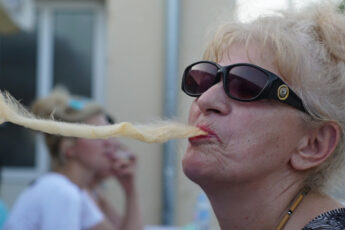A Feast for Color-Thirsty Eyes
Marcell Jankovics’ Son of the White Mare (Fehérlófia, 1981)
Vol. 139 (November 2023) by Julia Skala
Luckily for the audience at the 2023 goEast Film Festival in Wiesbaden, Germany, the programmers shared some beautiful Hungarian animation from the 1960s-80s as part of the event’s 23rd edition. This did not only include a variety of short films hailing from the Pannónia Filmstúdió, but also one of their animated feature films: Son of the White Mare, from 1981. It is the second animated feature film by Hungarian animation legend Marcell Jankovics, who is well-known for his expressive, minimalist short film Sisyphus (1974). In a fairytale narrative, Son of the White Mare depicts old Hungarian folklore and presents a boundlessness of colors, patterns, and mythology.
The plot of Son of the White Mare is based on the Hungarian myth Fehérlófia, although it deviates from its original inspiration somewhat. The film also contains elements of creation myths, for example Világfa, the world tree. According to Marcell Jankovics, earlier versions of the script had also emphasized the repetitiveness of history, but such themes were rejected since they did not align with the Marxist conviction of the linear flow of time. While the film was a huge disappointment at the box office back in the day, it is today treated as a treasured gem of artistic animation.
In Son of the White Mare, the world has fallen into disarray and is now reigned by creatures of the underworld, namely humanoid dragons, who haven taken it from the Forefather’s reign and his royal family. The three princesses who caused this adversity are doomed to live in the underworld, each married to one of the dragons.
This is the legend we learn about in the beginning of the film as we are guided by the narrative voice of the white mare. Her third – humanoid – son Fanyüvő (literally “Treeshaker”) seeks to become strong to fulfill the Forefather’s calling to go to the underworld and restore balance to the world. He is nursed by his horse mother until her death, until he has grown strong enough to lift the giant oak tree under which he grew up. He embarks on his quest and soon enough he encounters his brothers Kőmorzsoló (“Stonecrumbler”) and Vasgyúró (“Ironrubber”), who each turn out to have superhuman strength themselves. They wrestle to detect the strongest one among them, which turns out to be Fanyüvő. He is also the one to outsmart the mischievous gnome Hétszűnyű Kapanyányi Monyók (“Sevenwinged Skullsized Gnome”), who has tricked and overpowered his brothers before. Through Treeshaker’s victory, they detect the entrance to the Underworld, just below the gnome’s tree. He is also the only one among the brothers who dares to take the journey to the underworld, where he confronts and slays the dragons and hereby saves the princesses. Their castles turn into apples. When he seeks to transport them back to the aboveground world, the rope is too weak to carry Fanyüvő up with them and so he is left behind in the underworld. Meanwhile, the gnome has changed his mind and is now an ally, giving him the advice to seek the help of a griffin, with whom Fanyüvő makes a deal so he will be flown back to the upper world by the griffin after having helped him by saving his chicks from a serpent. During this endeavor, Fanyüvő also loses one of his legs to feed the griffin, which he is later given back for his service. Back in the aboveground world, the apples all turn into castles again and light up the upper world, Fanyüvő forgives his brothers for leaving him behind in the underworld and all of the brothers marry one of the princesses and shall live in the castles with them. The Forefather’s power is restored.
The plot of Son of the White Mare feels like a random arrangement of obstacles most of the time. We are taken from one encounter to the next one, from one bizarre inconvenience to another. When was the last time you saw heroes being held back by a gnome stealing their porridge and eating it from their bellies?
The narration has a way of feeling clumsy and arbitrary. This is amplified by the dialogs, which do not evoke another level of the story or a subtext. Instead they are kept very literal and obvious. This staleness of the narrative and dialogs stands in stark contrast to the visuals, with this disparity causing part of the film’s charm. The acting of the characters and how it is timed often feels mischievous, surprising, and silly, which jars so interestingly with the elaborate elegance of the film’s visual language.
Visually, Son of the White Mare is astounding. It draws from a beautiful palette of colors, including its three main heroes representing the three primary ones, in saturated yellow, blue and red. Jankovics states to have been inspired by Goethe’s color theory and by travels to India. The result is a style of graphic excellence, minimalist in many ways, boiling down the designs to essential shapes in expressive colors and renouncing black outlines for characters, as they were and are still often being used in animation. Yet it is maximalist in other ways, oozing with animated patterns reminiscent of Hungarian traditional folk dresses and with associative, abstract effect animations that transform one scene into another. The technique that was developed to achieve the latter was called Ink and Paint. In this process, the color was sprayed directly onto the cel sheets, allowing for fades to the next scene and color.
Besides the impressive, innovative visuals, the film’s content relies heavily on the proven. It tells a classic folktale in a linear, unagitated manner. The way the brothers wrestle for strength portrays a conservative understanding of gender and masculinity in particular. The princesses are merely beautiful, attractive and need to be saved – it goes without saying that this view of women is outdated as well. Unfortunately, there is nothing particularly surprising about this depiction given how old the film is.
Son of the White Mare is an excellent film to enjoy if you seek eye candy, a voluminous bouquet of colors and associative effect animations. The folktale it tells is one to lean back for – and while the narration may call for an occasional chuckle or facepalm vis-à-vis its absurdity, it lovingly tells a tale of Hungarian heritage. One thing is for certain: if you are an animation filmmaker or consider yourself a connoisseur of artistic animation, you cannot miss this film.




Leave a Comment